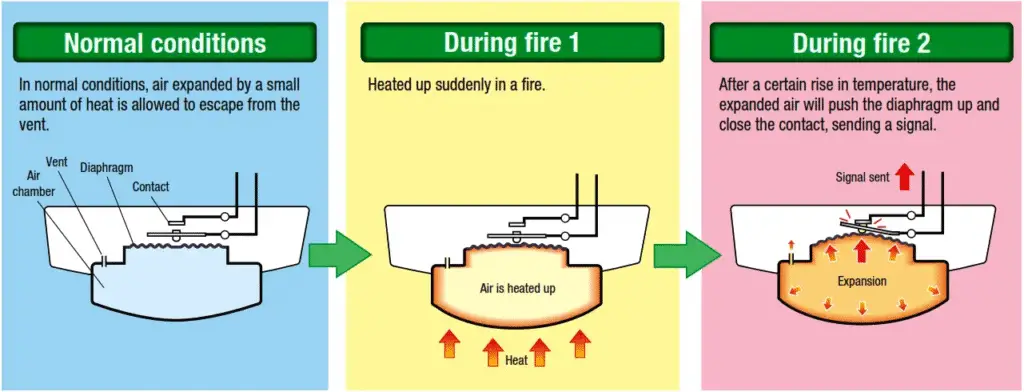Rate of rise heat detectors is a type of heat detector that responds when its element sense the increased temperature of thermal energy of a fire and buzzes an alarm. These detectors are also called rate of rise thermal detectors.
The thermal mass and conductivity of the element are used as parameters for regulating the rate of flow of heat into the element. Almost all heat detectors have a thermal lag. Heat detectors are of two types, rate of rise and fixed temperature heat detectors.

What is the Rate of Rise Heat Detectors?
When the rate of temperature increases in the surroundings and exceeds a certain rate, the rate of rise thermal detectors trigger a fire alarm. The air contained in the air chamber will expand when the rate of temperature increase exceeds a limit and thus results in the closing of contact which is used in generating an alarm.
As mentioned above, the rate of rise heat detectors will measure the rate at which the air temperature changes in an event of a fire. When the change in temperature is measured, it provides a faster alarm response as compared to the alarm response when measuring the temperature level in a space.
Construction of Rate of Rise Heat Detectors
The change in temperature of a space is measured by the rate of rise heat detectors by the use of a differential pressure switch. This differential pressure switch has an air chamber that is separated by a flexible diaphragm for the air in the ambiance.
The air chamber has a calibrated leak. This leak performs an important function so that normal temperature and pressure fluctuations inside the room space get adjusted across both sides of the diaphragm and do not cause the alarm contacts to close.
Working of Rate of Rise Heat Detectors
When there is a change in the air of the ambient space, the air pressure will increase and thus create a differential pressure across the diaphragm. During an event of a fire, the air temperature will rise at a faster rate compared to the change in normal conditions. This will lead to an increase in the pressure on the room side of the diaphragm. The leak is not able to compensate for such a huge pressure. therefore the diaphragm moves and closes the detector contacts.

Image Courtesy: Hochiki
Advantages
- Respond faster as compared to a fixed temperature detector.
- The rate of rise thermal detectors is not affected by the dusty or dirty environment.
- More reliable than smoke detector units.
- Economically feasible because they are cheaper than smoke detector units.
- Requires minimal maintenance.
Disadvantages
- They have lower responses as compared to smoke detectors.
- The rate of rise thermal detectors are not able to detect products of combustion.
- Suitable for the protection of property only
Example of Rate of Rise Thermal Detector
An example of the rate of rise thermal detectors is Honeywell’s HM/RHSE thermal detector. This is a rate of rise thermal detector by System Sensor. This rate of rise thermal detector is a point-type fire sensor. It provides an alarm when the rate of rise in the temperature of the room goes beyond 10°C per minute.
This rate of rise thermal detector can also provide an alarm when the ambient temperature of the room exceeds the threshold of 58°C. The sensing element used is a thermistor which has the ability to provide an early warning of developing fires. This rate of rise thermal detector also has addressable communication along with a fire alarm panel. It is categorized into Class A1R.
These rate of rise thermal detectors have a 360° local visual indication of the device status by the use of two integrated red LEDs. These rate of rise heat detectors possess some unique features also.

These rate of rise thermal detectors have rotary decade address switches. These rate of rise thermal detectors have a reliable and fast response. These rate of rise heat detectors work on advanced protocol and have smoothening filters for suppressing false alarms. This rate of rise thermal detectors come with a washable filter which makes them easy to maintain. This rate of rise heat detectors also has analog addressable communication.